________________
RELIGION
Ganges, Pahasa, Payāga, Avakhaṁda, Sirimāya and Keyāra.1
Of the above mentioned titthas, Ganges, as we know, was held to be the most sacred from ancient times. Here mention of the river Ganges as a tittha and not of the specific titthas situated on its bank is perhaps due to the fact that the Ganges was considered to be pure at all places. The Vayu Purana and the Kurma Purana clearly state that all parts of the Himalayas are holy and the Ganges is holy everywhere;2 Prabhasa or Pahasa, as it has been called in the text (modern Somnath in Junagarh dist., Gujarat), was another famous ancient tirtha which was regarded as deva-tirtha along with Kast and Puşkara.
329
Prayaga mentioned as a kutittha in the NC. is evidently the same as the Tirtharaja Prayaga of the Brahmins situated at the confluence of the three rivers at Allahabad. Yuan Chwang, who visited India during these centuries, also narrates the religious significance of this place. 5
Avakhamda is mentioned as another tirtha. This place, however, remains unidentified; the text seems to be corrupt at this place. Sirimaya as mentioned in the text is same as Śrīmāla, also known as Bhinmal or Bhillamāla, the famous capital of the Gurjaras; its religious significance as a tirtha, however, is not known. Keyara is another tirtha mentioned in the text; it might have been same as Kedara, a sub-tirtha in Varanasi or Kedaranatha in Tehri Garhwal.
Mention has also been made of the ancient Pukkhara
1. गंगा आदिग्गहणातो पहास - पयाग अवखंड - सिरिमाय (ल) केयारादिया एते सव्वे कुतित्था — NC. 2, p. 195.
2. Kane, P. V., loc. cit.
3. GD., p. 157.
4. Jain, op. cit., p. 322.
5. Beal, op. cit., pp. 232-34.
6. Jain, op. cit., p. 269. In the press copy of the Nisitha Curni prepared by Muni Punyavijayaji the text is to be found as Avarakanda.
7. GD., p. 192.
8. Kane, op. cit., p. 768.
Jain Education International
For Private & Personal Use Only
www.jainelibrary.org




